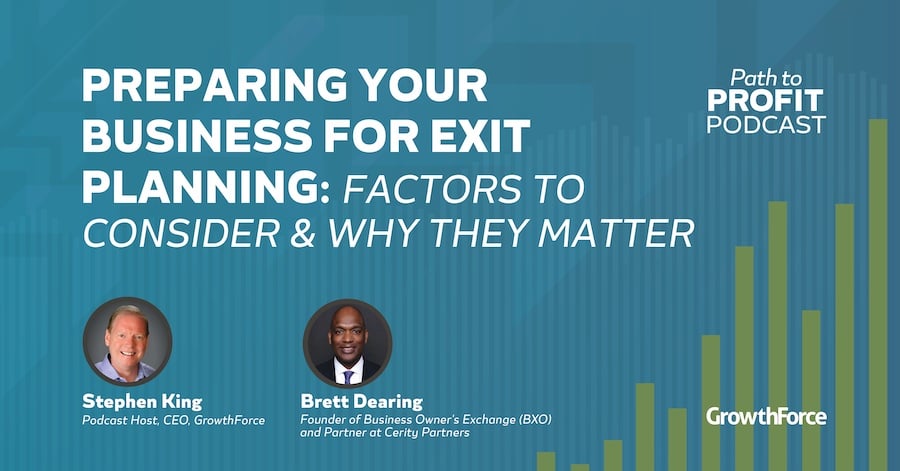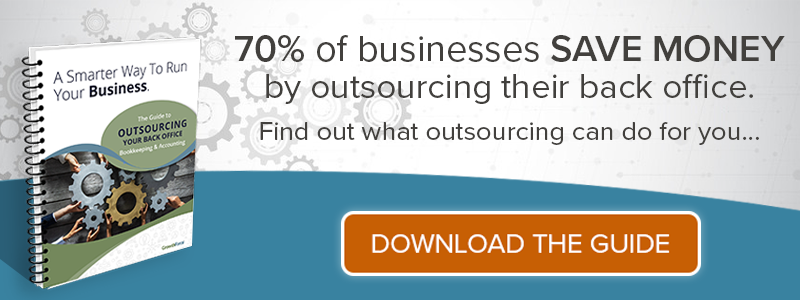7 min read

“The pandemic wasn't the cause of a lot of the issues that business owners are seeing. The pandemic essentially was a multiplier of a lot of the internal issues that businesses were already dealing with.”- Brett Dearing.
|
Key Takeaways
|
When you're first starting a business, the last thing on your mind is how you’re going to leave it. Because, let's face it, our businesses are our lives, passion, and our success.
However, if you want to see your business continue beyond your years, then you must start thinking about an exit strategy.
Whether exiting looks like selling, passing the torch or merging with another company, you need to start planning now to ensure a smooth exit and the continued strength of your company.
In this episode on the Path to Profit Podcast, GrowthForce CEO, Stephen King talks with Brett Dearing, founder of BXO, to talk about how important it is for business owners to start considering their business exit planning and strategy now and how exit planning has changed in light of challenges presented by the recession.
Dearing explains why exit planning is essential and offers advice on what business owners can start doing now to ensure a successful exit in the future.
→ Listen to the full episode here! 🎙
Why You Should Start Planning Your Business Exit Strategy Now
If you've never thought about exiting your business or haven't done anything yet to prepare yourself for your exit, you're not alone.
As Dearing explained, "[Business owners spend] 15, 20, 30 years building something, building this beautiful business. They're sitting at a table with all of these individuals around them to sell their business, and they're not prepared."
With the added strain of a more challenging economic climate, exit planning is more important now than ever before.
How Economic Uncertainty Has Affected Business Exit Strategy
Although the PPP loans and other grant programs have helped carry businesses through the past year, the effects of the pandemic have presented and will continue to present new challenges to business owners that have the power to impact profits, free cash flow, and overall business value.
This new economic climate is forecast to spur on considerable inflation rates. Dearing noted it's forecasted that the U.S. could reach 136% or as high as 150% debt to GDP this year. That's compared to normal levels that hover between about 70% and 80%.
"So, for you as a business owner, that means that you could be sitting in between inflation on one side and the increase in [the] cost of goods and a shrinking margin because of consumer spending or just a sluggish recovery to the economy," said Dearing. "You need to think about that and how you are planning to offset that as an owner."
No matter how strong a business is, it can only withstand so much economic pressure.
The recession has certainly created new challenges for businesses. According to Dearing, however, most of the problems businesses are facing during the pandemic aren't new; they're simply existing problems that were exposed and exacerbated by a tougher business climate.
Start Preparing Now to Exit Your Business Later
To ensure a successful exit or ownership transition, Dearing suggests business owners focus on these three areas:
- Prepare the business for the exit.
- Do the work to financially maximize proceeds.
- Personally prepare for your exit and transition into post-CEO life.
So, what do these three steps actually look like in practice? What should business owners be doing now to ensure their businesses are shored up and ready for a transition?
Dearing gives us the low down.
Step 1: Preparing the Business for Exit
This step is simply about determining what the exit is going to look like and how leadership will be transitioned.
Each part of this process should be outlined in the owner's exit strategy along with contingencies for things that might not go as planned.
It all starts with an assessment. “Just like when you go to the doctor to get a checkup. You don't know what's going on with your body unless you get a checkup. You don't know what's going on with your business unless you get a checkup. That checkup is an assessment,” Dearing said.
Business owners should be considering the following questions:
- Will the owner pass the torch onto a family member or designate another person to be the new CEO?
- What roles and responsibilities will the new CEO need to take on and how will you begin to prepare them to fill the position?
- If maintaining ownership, does the owner plan to stay involved in an advisory capacity?
- Does the owner plan to merge or sell the company outright?
- What will happen to the employees after the transfer of ownership?
- Who does the owner plan to tell when the time comes for the shift in leadership?
- How will the message be communicated throughout the organization?
- When will the news be spread?
When preparing to exit a business, it's essential to consider every aspect of what you do and do everything you can to ensure a smooth transition in leadership. These types of changes can be detrimental to businesses if not properly planned out and prepared for. Without adequate strategizing, your exit could lead to the company suffering negative changes in workplace culture, issues with congruity, and more.
Step 2: Financially Maximizing Proceeds
If planning to sell the business, a business owner needs to maintain impeccable financials, have the business assessed and valued regularly, and stay vigilantly focused on maximizing their profit margins. An attractive business is one with positive financial projections based on a solidly documented history of growth.
“More than 8 out of 10 business owners do not have a full-blown financial plan. They don't have a trust and estate plan. The biggest way to be able to save from a net proceeds perspective is having a gifting strategy that allows you to be able to take advantage of that.“ Dearing said.
This means you must begin shoring up your back office and financial records now so that your business will be worth more and more desirable to purchase when you're ready to exit in the future.
In addition to trimming expenses wherever possible, owners should analyze their financials closely, using job costing to look at profit & loss statements at a granular level to determine which services and clients are the most and least profitable. Owners should focus on expanding revenue channels with the strongest profit margins and eliminating those with weak margins.
Although it might seem counterintuitive, according to Dearing, it's not uncommon for business owners to cut revenue by nixing their least profitable products or services with the end goal of greatly improving profits.
Step 3: Figuring Out What Life Looks Like After Selling Your Business
For an exit strategy to be successful, it must be a positive experience for the business owner. On the other side of running a business, the business owner's life should still be purposeful. The owner should still be leaving behind a legacy. It's essential for a business owner to consider what life will be like when they no longer need to be at the office every morning.
While you might dream of scheduling daily tee times or buying a boat and sailing around the world, the fact is many business owners prefer to stay involved in their industries or with important causes. Dearing typically recommends that former business owners consider transitioning into new roles as board members in similar yet younger businesses or that they focus on taking an advisory board position in a nonprofit organization they care about.
Regardless of the purpose each business owner chooses for their retired life, it's important to find one so that you can stay busy, stay sharp, and continue working for a greater purpose.
A Smart Back Office For Every Stage of the Business Life Cycle
Keeping one eye on the economy and another on your bottom line, there's never been a better time than now to start your exit planning – even if you're still years away from selling or retiring.
Now is the time to build a better back office, get a handle on your financials, and focus on increasing your business's value so you can look forward to an easy exit when the time is right.
Management accounting allows business owners to seamlessly transition roles in their companies, exit gracefully, and pass the torch over to new management with peace of mind. With historic, current, and forecasted actionable financial insights at their fingertips, your successors will be able to make the data-driven decisions necessary to keep your business legacy thriving into the future.



